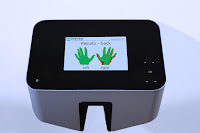Hand hygiene quality improvement by the Semmelweis Scanner
Hand
hygiene (HH) is believed to be the most efficient tool in fighting
hospital-acquired infections. Despite years of effort, caregivers’ HH
compliance remain low. In this study we investigated how the Semmelweis Scanner
can result HH quality improvement through automated training.
 Caregivers
were involved from a MICU and a NICU at an USA hospital in 2017. Caregiver’s
hand hygiene technique was regularly monitored by the Semmelweis Scanner.
The system computed the Semmelweis Hand Hygiene Quality (SHHQ) score (0–100),
which indicated the quality of HH. Hand hygiene was considered appropriate if 95+
SHHQ was reached. The integrated reporting system
provided real-time statistics about HH at a personal and institutional level.
Caregivers
were involved from a MICU and a NICU at an USA hospital in 2017. Caregiver’s
hand hygiene technique was regularly monitored by the Semmelweis Scanner.
The system computed the Semmelweis Hand Hygiene Quality (SHHQ) score (0–100),
which indicated the quality of HH. Hand hygiene was considered appropriate if 95+
SHHQ was reached. The integrated reporting system
provided real-time statistics about HH at a personal and institutional level.
92
caregivers took part in the program. The average SHHQ achieved by the MICU was
85±18% (mean ± standard deviation) and 89 ±14% by the NICU. Most frequently
missed areas were the thumbs and the fingertips. Rate of appropriate HH improved at both
units: only 28% of people passed on the first 4 days of the trial, while 81%
passed in the last 4 days.
Digital
HH training and evaluation allows for systematic, personalized data collection,
and it makes it possible to reach a larger fraction of the staff. This
technique can reveal typical week points in the caregivers’ HH practices, and
can be used efficiently to improve HH quality.
View our poster




Comments
Post a Comment